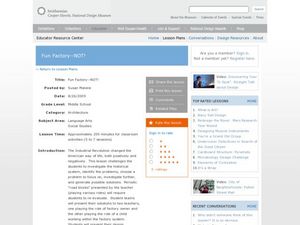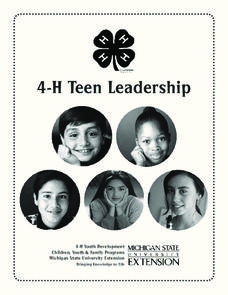Curated OER
Traders of the Lost Art
Learners work in small groups to investigate a variety of art and architecture forms common during the Old Kingdom epoch in Ancient Egypt. Learners then evaluate how these art forms reflect a culture's beliefs and values. And, finally,...
Nebraska Department of Education
This I Believe
As part of a Career Develop unit, eighth-graders reflect on their beliefs and values and consider how these beliefs might affect their relationships with friends and with colleagues when they join the workforce.
Quintessential Careers
Career Passion Worksheet
As pupils consider possible career paths for the future, give them the chance to reflect on their greatest skills, lifelong interests, favorite subject areas and activities, values, deeply rooted beliefs, etc.
Curated OER
Social Pyramid of Ancient Egypt
Sixth graders describe the defining characteristics of major world civilizations from political, social, and economic perspectives. They compare and contrast the religions in terms of leaders, beliefs and locations.
PBS
Who, Me? Biased?: Understanding Implicit Bias
A 10-page interactive explains different facets of implicit bias, demonstrates how implicit bias works, and how people can counteract its effects. The interactive tools permit users to save their information in "My Work" folders, to take...
College Board
2009 AP® Human Geography Free-Response Questions
Why have organic farms increased while dairy farms have decreased? Learners unravel this and other questions about geography, religion, and urban living patterns in a set of assessment questions. The resource includes short-answer...
Curated OER
Star Gazing
Third graders investigate what an astronomer is and what he studies in the solar system.
Curated OER
Personal Learning Profile
Students, after completing a Personal Learning Profile pre-test Survey, take a Personal Learning Profile pre-test. They explore personal interests, spiritual beliefs, strengths, needs, and habits. The questionnaire is completed on the...
Curated OER
Women in Business
Students work in group to discus similarities and differences of the characters in four films they have viewed. Each group presents their list to the entire class. Students fill in a grid with their ideas and discuss their personal...
Curated OER
Era of Self-Sufficiency - Pre-1890
Learners investigate the relationship between physical geography and Utah's settlement. In this Utah land lesson, students view a PowerPoint about Utah land and work in groups to answer questions about the uniqueness of Utah's Mormon...
Curated OER
Looking at Teachers Among Us: A Workshop in Conceptions of Teaching
Students characterize various traditional conceptions of teaching and apply these to authentic teaching situations. Teaching art, math and grading systems are analyzed in this lesson.
Curated OER
Islam - Hajj and Eid-ul-Adha, Panel Debate Teacher's Information
In this panel debate worksheet, students argue their assigned character's viewpoint regarding the importance of reading religious material. The worksheet is a guide for teacher's to utilize when holding a panel debate in class.
Curated OER
Fun-Factory - NOT!
Learners design a solution to a problem based on the Industrial Revolution. For this design lesson plan, students come up with architectural designs and present them to teachers in a simulated factory.
York Catholic
Elements of Drama
Introduce young actors to the key elements of performance with this handout that defines key staging terms and activities.
Curated OER
Cultural Ideas of Fashion
Learners examine the role of fashion and adornment in society. They discover the factors that influence different types of clothing. They also discuss how clothing reveals cultural clues about a society.
Curated OER
Transforming Energy
Super detailed, this lesson will educate physical science learners about the flow of electrons. Begin by reviewing potential and kinetic energy with a moving pendulum, and then get them online to observe interactive websites about...
Virginia Polytechnic Institute and State University
Lesson Plan: Omelet Cooking Principles
Although designed for a foods lab, the information in this resource might be just the thing for your own recipe notebook. Illustrated, step-by-step directions for making the perfect omelet, egg-citing puzzles, games, and even...
Michigan State University
4-H Teen Leadership
Take your 4-H teens to the next level! Help them learn how to be an active part of their communities with a teen leadership development unit. Individuals, together with school and community partners, create and execute a service-driven...
Curated OER
Do You Know What You're Really Getting In Your Pet Food?
Fifth graders examine advertising on wrappers and determine how it makes them feel about the product. They determine through a discussion the kinds of advertising/marketing techniques used to attract them to a product.
Curated OER
Exploring Careers
Fourth graders explore various careers and research the education and skills required, the job location and description, and the tools/instruments used.
Curated OER
Values Clarification
From 34 possibilities (and two blanks for other options), class members choose their top 10 values and rank them in ascending order to focus attention on what they want to prioritize in life. To the list, I'd add "service to others" and...
TV411
Learn the Steps to Clear Essay Writing!
Introduce your young writers to the five-paragraph expository essay format with a four-page worksheet that uses color codes to model for writers how to craft the essay. Although designed to prepare writers for the GED, the approach can...
Alabama Learning Exchange
The Five Senses: How They Relate to our World
Young scholars explore the five senses and the significance of each sense. In this five senses and diversity lesson, students listen to You Can't Smell a Flower With Your Ear by Joanna Cole and take a walk observing opportunities to use...
Curated OER
What Do Plants Need?
Students experiment with plants. In this plant lesson plan, students research the needs of plants. Students determine if all plants have the same requirements for growth. In small groups, students experiment with different plants.























